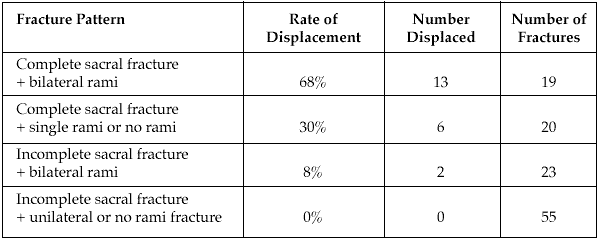
Thurs., 10/8/09 Pelvis & Acetabulum, Paper #34, 4:16 pm OTA-2009
Predicting Future Displacement of Non-Operatively Managed Sacral Fractures: Can It Be Done?
Brandon Bruce, MD1 (n); Mark Reilly, MD2 (4, 5B, 7-Stryker, Synthes; 4, 7-Smith &Nephew; 5B, 7-Stryker; 7-Biomet, EBI, Musculoskeletal Transplant Foundation, Wright Medical
Technology, Inc., Zimmer); Stephen H. Sims, MD1 (4-Synthes);
1Carolinas Medical Center, Charlotte, North Carolina, USA;
2New Jersey Medical School, Newark, New Jersey, USA
Purpose: This study was designed to analyze an established nonoperative protocol for the management of minimally or nondisplaced sacral fractures and to determine if certain fracture patterns are more prone to future displacement. The hypothesis was that patients would be able to mobilize early without further displacement.
Methods: From 2003 to 2007, radiographs of all pelvic ring injuries were reviewed at 2 Level 1 trauma centers with standard AP, cephalad, and caudad projection radiographs and pelvic CT scans. The study group consisted of those meeting inclusion criteria that consisted of age >17 years, <5 mm of initial sacral displacement, high-energy lateral compression mechanism, and radiographs documenting bony union. By protocol, patients meeting these criteria were mobilized with most allowed to weight-bear as tolerated and maintenance of alignment was documented by serial radiographs.
Results: 117 fractures met the inclusion criteria and were followed to union with radiographs. All fractures were classified according to the AO universal classification system and the Young and Burgess mechanistic classification system and consisted of type I lateral compression injuries as defined by Young and Burgess. Sacral fractures were additionally classified according to location as described by Denis and as to whether the fractures were complete (disruption of anterior and posterior cortices) or incomplete. Additionally, the number and location of rami fractures were recorded. Final radiographs were then compared with initial radiographs and significant displacement was documented. Displacement was determined to be significant if the pelvic union resulted in displacement of at least the width of the pubic rami or any additional measurable translational displacement of the sacrum. Of the initial 117 fractures, 21 were determined to displace and largely consisted of a single fracture pattern. Fractures consisting of a complete sacral fracture combined with bilateral rami fractures displaced at a rate of 68% (13/19). In contrast, incomplete sacral fractures with an ipsilateral rami injury had no displaced unions. The results of all fracture patterns are presented below.

Conclusion: Those with incomplete sacral fractures and ipsilateral rami can be treated nonoperatively and are unlikely to displace. However, consideration for surgical stabilization should be given for complete sacral fractures, especially those with a significant anterior injury.
• The FDA has not cleared this drug and/or medical device for the use described in this presentation (i.e., the drug or medical device is being discussed for an “off label” use). ◆FDA information not available at time of printing. Δ OTA Grant